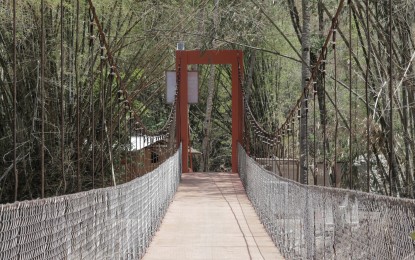
IMPROVING ACCESS. The hanging steel bridge in Sitio Sinuhot in Barangay Balubal, Cagayan de Oro City in this undated photo. The Department of Public Works and Highways (DPWH) on Tuesday (June 11, 2024) said the bridge has provided farmers and members of the Lumad Higaonon Tribe easy access to the remote community. (Photo courtesy of DPWH)
MANILA – Local farmers and members of the Lumad Higaonon Tribe are now benefitting from the hanging steel bridge in a remote area in Cagayan de Oro City which was completed by the Department of Public Works and Highways (DPWH).
In a news release Tuesday, DPWH-10 (Northern Mindanao) director Zenaida Tan said the PHP4.89-million bridge helped resolve the logistics woes of residents of Sitio Sinuhot in the city's Barangay Balubal and also reduced their transport expenses.
“Both pedestrians and motorcycles can use the bridge, making transport costs way cheaper compared to the hefty amount of PHP50 per sack which the farmers used to pay haulers for carrying their farm produce across the river,” she added.
Civil works on the completed hanging bridge project include the construction of a 34-meter steel bridge and access road, steel checkered plate for an anti-slip flooring, six-meter sheet piles, supported by 12-millimeter vertical, 32-millimeter backstay, and 25-millimeter main cables, and a hand-laid rock on both sides, Tan added.
The steel bridge, which was constructed by the DPWH Cagayan De Oro 2nd District Engineering Office, was proven critical due to pressing concerns about the safety of residents in the area, especially students who cross the bridge to go to school during the rainy season.
The completion of the bridge also facilitated easier and safer access to the town proper for the indigenous tribe’s necessities such as livelihood, education, and health services. (PNA)
